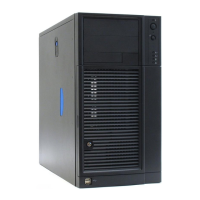Power Sub-system Intel
®
Entry Server Chassis SC5299-E TPS
Revision 3.1
Intel order number D37594-005
90
Table 110. AC Input Rating
Parameter MIN Rated V
MAX
I
MAX
Start up VAC Power Off VAC
Voltage (110) 90 V
rms
100-127 V
rms
140 V
rms
12 A
1,3
85VAC +/-
4VAC
75VAC +/-
5VAC
Voltage (220) 180 V
rms
200-240 V
rms
264 V
rms
7 A
2,3
Frequency 47 Hz 50/60 63 Hz
1. Maximum input current at low input voltage range is measured at 90VAC, at max load.
2. Maximum input current at high input voltage range is measured at 180VAC, at max load.
3. This requirement is not used for determining agency input current markings.
2.5.7.4 Efficiency
The following table provides the required minimum efficiency level at various loading conditions.
These efficiency levels are provided at three different load levels: 100%, 50% and 20%.
Efficiency is tested over an AC input voltage range of 115VAC to 220VAC.
Table 111. Efficiency
Loading 100% of Maximum 50% of Maximum 20% of Maximum
Recommended Efficiency 68% 72% 65%
2.5.7.5 AC Line Dropout/Holdup
Table 112. AC Line Dropout/Holdup
Output Wattage Loading Holdup time
670W 100% 20 ms
An AC line dropout is defined to be when the AC input drops to 0VAC at any phase of the AC
line for any length of time. During an AC dropout, the power supply meets dynamic voltage
regulation requirements. An AC line dropout of any duration does not cause any tripping of
control signals or protection circuits. If the AC dropout lasts longer than the hold up time, the
power recovers and meets all turn on requirements. The power supply meets the AC dropout
requirement over rated AC voltages and frequencies. A dropout of the AC line for any duration
does not cause damage to the power supply.
2.5.7.5.1 AC Line 5VSB Holdup
The 5VSB output voltage stays in regulation under its full load (static or dynamic) during an AC
dropout of 70ms min (=5VSB holdup time) whether the power supply is in the ON or OFF state
(PSON asserted or de-asserted).

